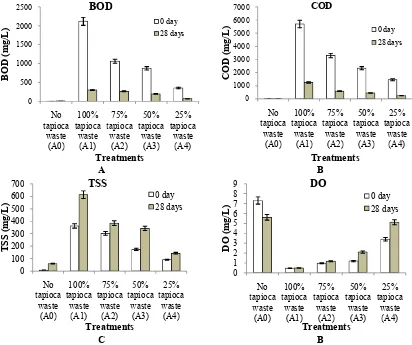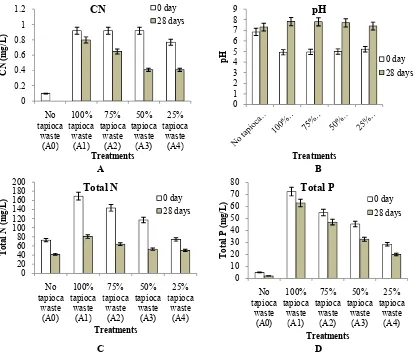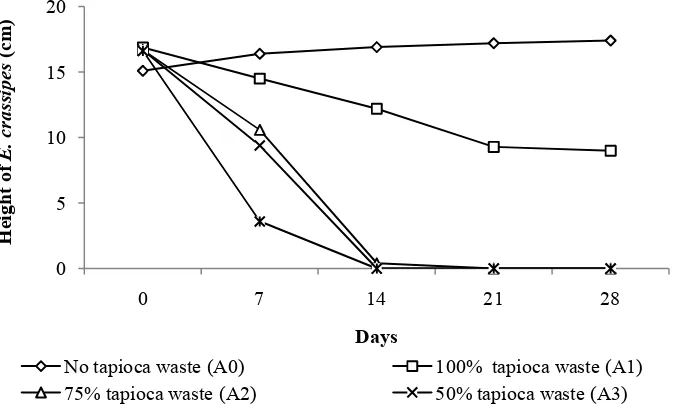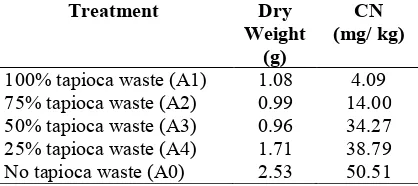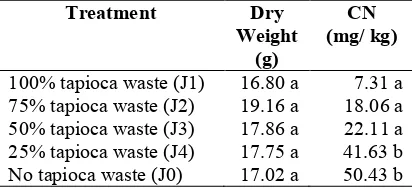ISSN: 2339-076X, Volume 2, Number 2 (January 2015): 295 - 302
DOI:10.15243/jdmlm.2014.022.295
Research Article
Phytoremediation of tapioca wastewater using water hyacinth plant
(
Eichhornia crassipes
)
Y. Nuraini
*, M. Felani
IRC-MEDMIND, Brawijaya University, Jl. Veteran, Malang 65145, Indonesia
*
corresponding author: [email protected].
Abstract:
The objective of this study was to elucidate the possible phytoremediation of liquid waste of tapioca industry using Eichhornia crassipesprior its usage for watering maize grown on an Entisol of Malang. Tapioca liquid waste was mixed with pure water at various concentrations and thenEichhornia crassipes was grown on a water bath filled with the mixture. After twenty eight days, the mixture of tapioca liquid waste and pure water was analyzed for BOD, BOD, COD, DO, TSS, CN, total N, and total P, prior to its usage for watering maize grown on a pot filled with an Entisol. Results of this study showed that during twenty eight days Eichhornia crassipes grown on 25% tapioca wastewater was capable to reduce BOD, COD, and CN concentrations of the liquid waste and to increase pH of the the mixture of liquid and pure water. This has resulted in a significant increase of maize growth.Keywords: Eichhornia crassipes, phytoremediation, tapioca, waste
Introduction
In the processing of tapioca flour, residual wastes in the form of solid, liquid, or gas are produced. Of the three types of waste, liquid waste often causes negative impacts to waters if the wastewater produced is not properly managed before it is disposed into water bodies. Environmental pollution will not occur in case of these wastes if they are treated before disposal. Treatment aims to reduce waste contaminated and toxic materials until the levels are reduced and even if possible eliminate it completely before they are discharged. Although the Indonesia Government has set regulations on procedures for the disposal of toxic waste, but in practice in the field is still many pollution caused by industrial waste either in the form of solid or liquid waste.
Wastewater treatment can be done physically, chemically, and biologically. Biological treatment uses microorganisms and higher plants. In an effort to restore contaminated soil and water, micronutrients and organic substances toxic industrial wastewater pollution, then lately done by using crop management. Some plants are naturally very effective at absorbing and accumulate various toxic metals and organic
substances in plant tissues (Environmental Protection Agency, 2001) and the cost is relatively cheap.
A new technology that uses plants to clean variation, decrease, or extract contaminants from soil and water process is called phytoremediation. Phytoremediation technology works well in places with less pollution even to the level of pollution is. In this remediation process, plant transfers hazardous chemicals from the place where the roots take water and nutrients from contaminated soil, rivers, and underground water. Chemicals are absorbed by the plant is stored in the roots, stems, and leaves that will be converted into less harmful chemicals, converted in the form of gas and is released into the air in the process of transpiration (Schnoor, 2002).
chemical oxygen demand (COD) and total suspended soils (TSS) by 76.38%, 73.67%, and 80.77%, respectively.
Based on the ability of the above, the water hyacinth is thought to be very effective in remediating the contaminated area. So far, studies on the use of water hyacinth plant for remediation of tapioca wastewater in East Java of Indonesia are limited. The objective of this study was, therefore, to identify the ability of water hyacinth in remediation of tapioca wastewater.
Materials and Methods
The experiment was conducted in the greenhouse of the Faculty of Agriculture, Brawijaya University from January to April 2009. Liquid waste used for this was wastewater of tapioca flour processing plant at Dampit of South Malang. Characteristics of the tapioca wastewater were as follows: BOD (Biological Oxygen Demand) of 2121.1 mg / L, COD (Chemical Oxygen Demand) of 5709 mg / L, TSS (Total Suspended Solid) of 362.8 mg / L, CN (cyanide) of 0.92 mg / L, and DO (Dissolved Oxygen) of 0.48 mg / L. These values exceeded the e maximum levels according to the decree of Governor of East Java of 2002 on effluent standard for tapioca wastewater for COD 300 mg / L, BOD 150 mg / L, TSS 100 mg / L), and CN 0.2 mg / L).
The experiment was conducted in two phases. The first phase of the research aimed to study the resistance of water hyacinth plants that grow in the wastewater medium at various concentrations. Five treatments, i.e. 100% liquid waste (A1), 75% liquid waste + 25% freshwater (A2), 50% liquid waste + 50% freshwater (A3), 25% liquid waste + 75% freshwater (A4), and 100% fresh water (A0) were arranged in a completely randomized design with three replications.
Each mixture (38 L) was placed in a plastic pot (46 cm in diameter and 24.5 cm high). Young water hyacinth plant was then grown in the pot for 28 days. Plant growth parameters observed were percentage of plant growth, plant height, number of leaves, dry weight, levels of CN. The waste parameters observed were pH, BOD, COD, DO, TSS, and CN. After harvest (28 days), the media remaining in each pot was then used for watering soil media in separate pots for planting maize. Treatments applied for maize planting were similar that that of water hyacinth experiment. The maize was grown for 28 days. At harvest (28 days), maize crop parameters measured were plant height, number of leaves, dry weight, and CN
Results and Discussion
Quality of tapioca wastewater
BOD
During the process of phytoremediation of tapioca wastewater using water hyacinth as phytoremediator, the average values of BOD at various concentrations of tapioca wastewater decreased (Figure 1A). This was presumably because the amount of oxygen needed by microorganisms in decomposing organic material decreased with increasing dissolved oxygen in the water due to photosynthesis activity (Morrice et al,. 2008). Treatment A1 had higher BOD loadings than other treatments. This was because of high concentration of tapioca wastewater.
COD
The average value of tapioca wastewater COD decreased with decreasing proportion of tapioca wastewater (Figure 1B). Treatment A1 had higher COD content than other treatments. According to Effendi (2003), the total amount of oxygen required to oxidize organic materials chemically, both of which can be degraded biologically (biodegradable) and is difficult to degrade biologically (non-biodegradable) into CO2 and H2O.
TSS
TSS value of tapioca wastewater that has undergone processing by water hyacinth plant in general increased (Figure 1C). This occurred in addition to the high concentration of waste solids derived also the presence of water hyacinth plant either in the form of roots, debris or rotting leaves and stems in water. According to Murphy (2007), factors that cause TSS include high surface runoff, soil erosion, water waste, and decaying plants and animals. Effendi (2003) also indicated that the total suspended solids are suspended materials (diameter> 1 m) retained on the millipore filter with a pore diameter of 0.45 m. TSS consists of silt and fine sand as well as the remains of microorganisms, which are mainly caused by piling soil or soil erosion, are carried to water bodies. This was evident in the control treatment (A0) which initially was clean water after water hyacinth was planted for 28 days. DO
tapioca wastewater and low photosynthetic activity in terms of percentage of growth when water hyacinth plants were only able to grow until day 8. Similarly, the treatments of A2 and A3 were only able to grow until day 12. The differences in the concentration of tapioca wastewater were associated with the role of photosynthesis by plants or water hyacinth
phytoplankton in the waters. In the process of photosynthesis, carbon dioxide is reduced to carbohydrate and water undergoes dehydrogenation into oxygen (Effendi, 2003). According to Murphy (2007), reduced photosynthesis causes a lack of dissolved oxygen that is released into the water by the plant.
A B
C B
Figure 1. BOD, COD, TSS and DO at various concentrations of tapioca wastewater
CN (cyanide)
The average CN content decreased in all treatments (Figure 2A). Treatments A3 and A4 gave good results compared to the treatment of A1 and A2 with an average value of CN was low at 0.40 mg / L, while the control contains the lowest CN lowest among other treatments. According to Young and Jordan (1996), many species of bacteria, fungi, algae, and plants with linkages between enzymes and amino acids they own have been known to oxidize cyanide naturally.
pH
An increase in pH at various concentrations of tapioca wastewater occurred on day 28 (Figure 2B). Treatment A1 showed the average pH value of the lowest compared to other treatments, unlike the case with A0 treatment that increased the pH value of 6.86 at day 0 to 7.84 at day 28. Activity of microorganisms to decompose organic matter in the wastewater is also associated with photosynthetic activity that takes CO2dissolved in the form H2CO3 that causes an increase in pH (Morrice et al., 2008).
Total N
The average value of total N at various concentrations of tapioca wastewater generally decreased after a treatment for 28 days (Figure 2C). This occurred because of the plant N uptake (Syekfani, 1997), bound by microorganisms (Sastrawijaya, 1991), a process of denitrification (Henze et al., 1997), or ammonia volatilization (Effendi, 2003). In this case, because the concentration of tapioca wastewater of treatment A1 was higher than A2, A3, and A4 treatments, it was possible that in addition to N losses absorbed by plants, but it was also due to the activity of
microorganisms that require N for the formation of the body.
Total P
The average P-total at various concentrations of tapioca wastewater generally decreased after a treatment for 28 days (Figure 2D). Decreasing levels of P-total in all treatments was probably due to the activity of microorganisms that use P for metabolic processes. P originally used by plants and microbes use dissolved inorganic P to do with the process of photosynthesis, chemosynthesis and decomposition (Welch, 1996).
A B
C D
Figure 2. CN, pH, total N, and total P at various concentrations of tapioca wastewater
Growth of water hyacinth plant
All treatments showed the same growth pattern, i.e. the higher the concentration of tapioca wastewater the lower was the percentage growth of water hyacinth plant (Figure 3). At a
respectively. This indicated that the high BOD, COD, TSS, and CN and the low dissolved oxygen and pH in the planting media inhibited growth of hyacinth plants (Marianto, 2001).
Height of water hyacinth plant
The average value of plant height at various concentrations of tapioca wastewater decreased, whereas in the control (A0) increased (Figure 4). The decrease in plant height in the treatment of A1 resulting in high waste contaminated materials, so the plant was difficult to adapt to the environmental conditions of poor water quality (Murphy, 2007).
Number of leaves of water hyacinth plant
The number of leaves of water hyacinth plants in treatment A1 was significantly lower than treatments A2, A3, and A4 (Figure 5). The possibility of this was due to the high concentration of BOD, COD, TSS, and CN of the A1 treatment that made plants was difficult to adapt to poor water quality. In contrast to the control treatment (A0), the number of leaves increased due to good water quality for water hyacinth plant growth (Murphy, 2007).
Figure 3. Growth of water hyacinth at various concentrations of tapioca wastewater
Figure 4. Height of hyacinth leaves at various concentrations of tapioca wastewater 0
20 40 60 80 100 120
4 8 12 16 20 24 28
P
er
ce
n
ta
g
e
o
f
E
.c
ra
ss
ip
es
g
ro
w
th
Days
100% tapioca waste (A1) 75% tapioca waste (A2) 50% tapioca waste (A3) 25% tapioca waste (A4)
0 5 10 15 20
0 7 14 21 28
H
ei
g
h
t
o
f
E
.
cr
a
ss
ip
es
(c
m
)
Days
Figure 5. Number of water hyacinth leaves at various concentrations of tapioca wastewater
Dry weight and CN content of hyacinth plant
The lower the concentration of effluent will further increase the tapioca plant dry weight (Table 1). This was because of the high concentration of tapioca wastewater having high concentrations of (BOD, COD, TSS, and CN) that made plant were able to growth normally until day 28. This is evident in the treatment of A1, A2, and A3 that had lower dry weight values of 1.08 g / plant, 0.99 g / plant, and 0.96 g / plant, respectively, compared to the A4 treatment that amounted to 1.71 g / plant. The highest plant dry weight obtained in the control treatment (A0) was to 2.53 g / plant. The low dry weight in treatments A1, A2, and A3 because the water hyacinth plants were not able to grow well under conditions of high BOD, COD, TSS, and CN concentrations and low dissolved oxygen that inhibited plant growth and cause of death of the plants. A1 treatment plant produced CN level higher than treatments A2, A3, A4, and A0 (Table 1).
Table 1 Average dry weight and CB content of water hyacinth plant.
Treatment Dry
Weight (g)
CN (mg/ kg)
100% tapioca waste (A1) 1.08 4.09 75% tapioca waste (A2) 0.99 14.00 50% tapioca waste (A3) 0.96 34.27 25% tapioca waste (A4) 1.71 38.79 No tapioca waste (A0) 2.53 50.51 Remarks: Mean values accompanied by the same letter do not show significant differences in Duncan's test (p = 0.05).
lowest obtained from A0 treatment was4.09 mg / kg. Marianto (2001) explained that the water hyacinth is able to neutralize pollutants, through the dense roots that pollutants are absorbed for use in the process of metabolism.
Effect of post-phytoremediation wastewater on maize growth
Plant height
The measurement results showed that all treatments showed a similar growth pattern with increasing time. Figure 6 shows the sequence of J1> J2> J3> J4> J0. The watering of 100% post-phytoremediation tapioca wastewater (J1) made plants able to absorb nutrients from wastewater including N and P more than the other treatments. Because the post- phytoremediation wastewater contained high nutrients, application of the high concentration of post-phytoremediation tapioca wastewater improved the growth of plants. Nitrogen is needed as the constituent amino acids, nucleic acids, and energy transfer materials. In addition to the formation of new cells including stem elongation, leaf expansion and the formation and enlargement of the stem needed enough nitrogen (Rusprasita et al., 2001).
Number of leaves
The observation of the average number of maize leaves can be seen in Figure 7. At 7, 14, 21, and 28 days after planting watering treatment of various concentrations of post-phytoremediation tapioca wastewater did not show significant differences. At 35 and 42 days after planting showed that the number of leaves of maize plants at J1 and J2 treatment were greater compared to
-2 4 6 8
0 7 14 21 28
N
u
m
b
er
o
f
E
.
cr
a
ss
ip
es
le
a
v
es
Days
compared to the J3 and J4 treatments. At 35 days after planting the number of leaves shown in J1 and J2 treatment were as many as 11 pieces /
plant. At 42 days after planting the most number of leaves shown in J1 and J2 treatment were as many as 14 pieces / plant.
Figure 6. Changes in height of maize plant
Figure 7. Changes in number of leaves of maize plant after 42 days
Dry weight and CN content
The highest maize plant dry weight was observed for J1 treatment, which amounted to 19.16 g, while the average lowest maize plant dry weight indicated in the treatment of J0, was equal to 16.80 g (Table 2). The high dry weight of maize plants in J1 post phytoremediation wastewater treatment was probably due the relatively higher nutrients content (including N and P) compared to fresh water (no tapioca liquid waste), so the possibility of easily available nutrients that could be taken up by plants.
Table 2. Average dry weight and CN content of maize plant.
Treatment Dry
Weight (g)
CN (mg/ kg)
100% tapioca waste (J1) 16.80 a 7.31 a 75% tapioca waste (J2) 19.16 a 18.06 a 50% tapioca waste (J3) 17.86 a 22.11 a 25% tapioca waste (J4) 17.75 a 41.63 b No tapioca waste (J0) 17.02 a 50.43 b Remarks: Values accompanied by the same letter do not show significant differences in Duncan's test (p = 0.05).
-10 20 30 40 50 60 70 80 90 100
7 14 21 28 35 42
H
ei
g
h
t
o
f
m
a
iz
e
p
la
n
t
(c
m
)
Days No tapioca waste
100% tapioca waste 75% tapioca waste 50% tapioca waste 25% tapioca waste
-2 4 6 8 10 12 14 16
7 14 21 28 35 42
N
u
m
b
er
o
f
m
a
iz
e
le
a
v
es
Days No tapioca waste
The low dry weight of the J0 treatment because this treatment contained fewer nutrients (including N and P) compared to other treatments so that nutrients needed by plants were less available. J1 treatment plant produced CN levels higher than J2, J3, J4, and J0 treatments (Table 2). The highest level of CN obtained from maize plants treated with J1 was equal to 50.43 mg / kg and the lowest obtained from J0 treatment was 7.31 mg / kg.
Basically, the cyanide content of maize plants watered with post-phytoremediation tapioca wastewater was still below the maximum threshold levels of cyanide in maize of 75 mg / kg based on the joint decision of the Ministry of Health and Ministry of Agriculture. This is because the maize plants are able to uptake the CN in the soil caused by watering post-phytoremediation tapioca wastewater. Plants move harmful chemicals materials from the soil when the roots take water and nutrients from the contaminated soil, stream water, and groundwater.
Conclusion
Water hyacinth plant as phytoremediator for 28 days was only able to grow at a concentration of 25% tapioca wastewater. The higher the concentration of post-phytoremediation tapioca wastewater given into an Entisol of Dampit planted the maize the higher were the plant height, leaf number, and dry weight of the maize plant. The CN content in the maize but was still below the set threshold.
Acknowledgements
The authors wish to thank PT Indofood for financial support to undertake this study.
References
Effendi, H. 2003. Telaah Kualitas Air, Bagi
Pengelolaan Sumber Daya dan Lingkungan
Perairan. Kanisius. Yogyakarta.
Effendi, U. 1988. Netralisasi Limbah Cair Industri Tapioka Secara Biofiltrasi dengan Menggunakan
Enceng gondok (Eichornia cressipes). Agrivita
11(2): 35-36.
Environmental Protection Agency. 2001. A Citizen’s
Guide to Phytoremediation. Available at
http://www.clu-in.org/download / citizens/ citphyto. pdf .
Henze, M., Harremoes, P., Jansen, J.C., and Arvin, E.
1997. Wastewater Treatment Biological and
Chemical Processes. Springer-Verlag. Berlin. Marianto, L. A. 2001. Merawat dan Menata Tanaman
Moenandir, J. dan Hidayat, S. 1993. Peranan enceng gondok dan kangkung air pada peningkatan mutu
air limbah.Agrivita16(2): 54-57
Moenandir, J. dan Irawan, A. 1993. Kemampuan
enceng gondok, kiambang dan tawas dalam
penjernihan bahan baku air minum.Agrivita16(2):
58-60
Morrice, J.A., Danz, N.P., Regal, R.R., Kelly, J.R., Niemi, G.J., Reavie, E.D., Hollenhorst, T.P., Axler, R.P., Trebitz, A.S., Cotter, A.M. and Peterson, G.S. 2008. Human influences on water quality in Great
Lakes coastal wetlands. Environmental
Management41:347-357.
Murphy, S. 2007. General Information on Solids.
USGS Water Quality Monitoring.
http://bcn.boulder.co.us/basin/data/BACT/info/TSS. htm
Priyanto, B., dan Prayitno, J. 2005. Fitoremediasi Sebagai Sebuah Teknologi Pemulihan Pencemaran,
Khususnya Logam Berat. Available at
http://www.ltl.bppt.com/sublab/lflora1.htm Rusprasita, Y., Agustina, L., Syekhfani, dan Premono,
E. 2001. Status dan efisiensi penggunaan nitrogen
selama pertumbuhan tanaman tebu keprasan
(Saccharum officininarum L.) yang dipupuk
sipramin.Biosain1(1).: 10-14
Sastrawijaya, A. T. 1991. Pencemaran Lingkungan. PT. Rineka Cipta. Jakarta.
Schnoor, J.L. 2002. Phytoremediation of Soil and
Groundwater. Groundwater Remediation
Technologies Analysis Center. Technology
Evaluation Report. TE-02-01: 1-45.
Sugiharto. 1987. Dasar-dasar Pengelolaan Air Limbah. UI Press. Jakarta.
Syekfani. 1997. Hara-Air-Tanah-Tanaman. Jurusan Tanah. Fakultas Pertanian. Universitas Brawijaya. Malang.
Welch, E. B. 1996. Ecological Effects of Wastewater: Applied Limnology and Pollutant Effects. E&FN Spon. London.
Young, C. A. and Jordan, T.S. 1996. Cyanide
Remediation: Current and Past Technologies.
